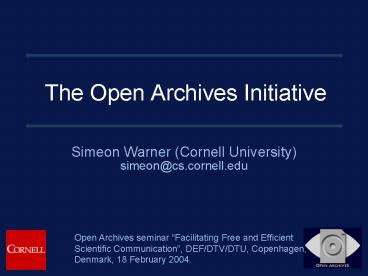The Open Archives Initiative - PowerPoint PPT Presentation
1 / 24
Title:
The Open Archives Initiative
Description:
'The Open Archives Initiative has been set up to create a forum to discuss and ... (Harvester) Protocol requests. XML metadata 'OAI-PMH' Simple protocol. ... – PowerPoint PPT presentation
Number of Views:43
Avg rating:3.0/5.0
Title: The Open Archives Initiative
1
The Open Archives Initiative
- Simeon Warner (Cornell University)
- simeon_at_cs.cornell.edu
Open Archives seminar Facilitating Free and
Efficient Scientific Communication,
DEF/DTV/DTU, Copenhagen, Denmark, 18 February
2004.
2
Where does the OAI fit?
3
Origins of the OAI
The Open Archives Initiative has been set up to
create a forum to discuss and solve matters of
interoperability between electronic preprint
solutions, as a way to promote their global
acceptance. (Paul Ginsparg, Rick Luce
Herbert Van de Sompel - 1999)
4
What is the OAI now?
The OAI develops and promotes interoperability st
andards that aim to facilitate the efficient
dissemination of content. (from OAI mission
statement)
- Technological framework around OAI-PMH protocol
- Application independent
- Independent of economic model for content
- Also a community and a brand
5
OAI in context
establish a technological basis that allows
other issues to be addressed
6
OAI and Open Access
- There is A difference
- Open Archives Initiative
- Open Access
- The OAI is not tied to a particular political
agenda - technical focus - BUT the OAI provides functionality that is
essential for many Open Access proposals
7
OAI Protocol for Metadata Harvesting
- OAI-PMH
- Simple protocol. Free implementations available.
- Designed to allow harvesting of any XML metadata
(schema described)
8
OAI-PMH - M is for Metadata
- Simple Dublin Core mandated for base level
interoperability - DC typically generated by automated cross-walk if
base metadata is not DC - Support for multiple metadata formats, e.g.
expose MARC and DC for single item - Strategy perhaps gone slightly awry, service
providers complain about bad metadata and bad use
of DC. Data providers should also expose original
format
9
OAI for discovery
R1
R2
?
User
R3
R4
Information islands
10
OAI for discovery
Service layer
R1
R2
Search service
User
R3
R4
Metadata harvested by service
11
OAI for XYZ
Service layer
R1
R2
XYZ service
User
R3
R4
Global network of resources exposing metadata
12
Building the network
- Services have to be able to locate repositories
- Outside knowledge
- Through OAI registry
- Through ltfriendsgt data
- Still issues of selection and local collection
building - Network may contain intermediate aggregators and
proxies
13
Too small to implement OAI-PMH?
- e.g. a collection of 100 working papers
- Static repository version of OAI
- Expose XML file on web server
- Register with gateway
ltxmlgt
ltxmlgt
R1
R2
14
Facilitating New Models of Scholarly Communication
- The role of the OAI in Open Access models,
institutional repositories and perhaps in
disaggregated systems
15
Eprint archives
- Eprint
- Scholarly literature including journal articles,
pre-prints, technical reports, books , theses and
dissertations. May or may not be refereed. - Open Access to full-content via Internet
- Archives (metadata available via OAI)
- arXiv (aka xxx) eprint archive (260k eprints)
- RePEc (231k records, 6k eprints)
- NASA NTRS (368k records, 12k eprints)
- NDLTD (e.g. VTETD, 3.6k total, 2.4k eprints)
- CERN Document Server (41k eprints)
- Organic eprints (1.4k eprints)
16
Institutional repositories
- Institutionally defined content generated by
institutional community - Scholarly content preprints and working papers,
published articles, enduring teaching materials,
student theses, etc. - Cumulative and perpetual preserve ongoing access
to material - Open Access free, online
- Interoperable?
17
Institutional repositories
18
Obstacles to implementation
- Technical issues
- global level/interoperability (OAI, )
- institutional level
- Unknown cost parameters (now starting to get
experience) - Dependence on current journal system role in
academic advancement (rewarding) - Systemic inertia
- Faculty participation
19
New library positions?
capture and share the input
portals and services
L I B
L I B
R
A
?
?
20
Disaggregation?
- Traditional journal publishing combines
functions registration, certification,
awareness, archiving. - How about eprints being the starting point of a
new value chain in which the raw material - the
non-certified eprint - is open access? - Other functions might be fullfilled by different
networked parties
21
A disaggregated view
awareness
certification
rewarding
A
R
registration
archiving
OAI
22
OAI in a disaggregated system
- Achieve interoperability by ensuring that
information about the fulfillment of the
different functions - can travel across the system
- can be shared by nodes of the system
23
The promise of the OAI
- So far harvesting of descriptive metadata,
search and browse services - Provides necessary infrastructure for the growing
number of discipline-specific and institutionally
based repositories. - Better interoperability will promote adoption of
Open Access models. - Will support new, disaggregated models of
scholarly communication.
24
Questions?































